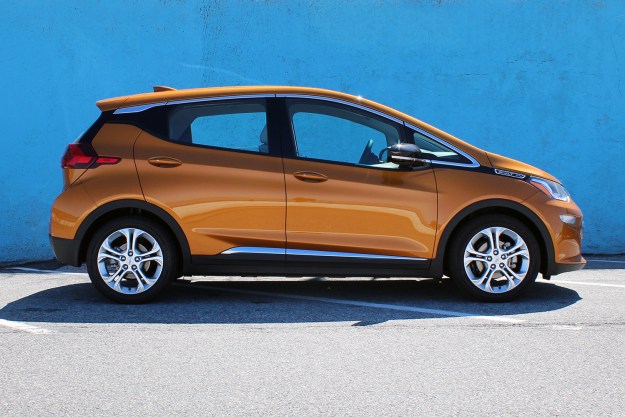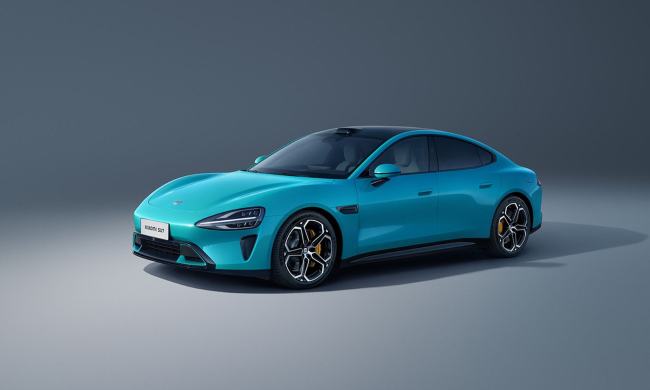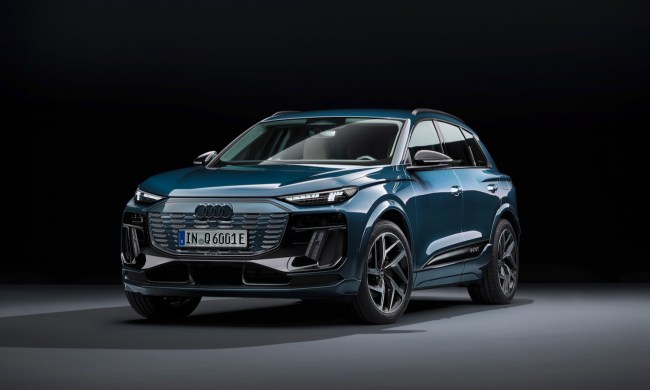
- Long range for an attainable price
- Spacious interior
- Excellent visibility
- Attractive looks
- Affordable price
- Low price, but with an asterisk
- Sporty, she is not
- Collision alert sensors are not standard
We’ve passed the period when all-electric cars were an oddity, but EVs aren’t fully commonplace. Tesla is no longer an upstart but an established automaker, and yet its offerings are still too upscale to make them regular sites around town. Other automakers have expanded their lines to offer their own fully-electric models, but even those have since been limited to short-range urban runabouts.
Chevrolet is the first to the table with the Chevrolet Bolt, an EV that has long range, but without the boutique price. Does it succeed? I took the plucky EV home to find out, starting with a drive from New York city to Long Island that would trigger some heavy range anxiety.
What’s New
The Bolt EV is an all-new fully electric vehicle from Chevrolet that hopes to hit that EV sweet spot between long range and affordability. Specifically, the Bolt looks to provide an EPA-estimated range of 238 miles while remaining attainable for less than $30,000, after a $7,500 federal tax credit.
Trim levels & features
The Bolt comes in two trims: LT and Premiere. LT will net you stuff like 17-inch painted aluminum wheels, HID headlamps, 10 airbags, a 10.2-inch MyLink touch screen, two front USB ports, XM Radio, and seating for five.
Spring for Premiere, and you net the above plus nifty extras that include heated seats, collision alert, lane keep assist/departure warning, and an extra two USB ports for the rear seats. Chevy’s rear camera mirror is also available in this trim. This is the function that allows drivers to flip between a regular rear view mirror and a wide-angle rear camera display right inside the mirror casing.
Technology overview
The Bolt’s modest interior is home to a 10.2-inch touchscreen, which lets passengers access the car’s MyLink apps. For the most part this consists of different audio sources, the phone you’ve paired to the vehicle, and a screen for your battery consumption. While you’re on the go, this will give you an idea of how economical you’re being with your driving. A graphic shows the Bolt ether expending juice or regenerating power.
No one will know that it’s an electric car, though they might wonder how you snuck up behind them so silently.
Will you use it much? Not likely. The digital gauge cluster gives you the same information with less invasiveness and is in your line of sight. But the screen does give you a summary of your usage once you’ve stopped, allowing you to adjust your driving behavior accordingly. There’s little more to it than that, so it’s a good thing the Bolt EV is Apple CarPlay and Android Auto compatible, allowing you to access to your preferred music apps as well as giving you in-dash navigation.
You’ll spend a lot of time checking the digital gauge cluster that displays your estimated range and power drain. You’d be surprised to see how much this influences your driving. Getting the Bolt to recoup some spent miles through coasting or braking will be your new favorite game.
Interior fit & finish
The Bolt’s interior may be spartan, but ample room makes it comfortable, at least. The beautiful thing about EV architecture is that it needs less space for components, so after Chevy laid down the batteries in the floor, the final two were stacked in the back to make the rear seats. Specifically, you get 39.7-inch and 41.6-inch of headroom/legroom in the front, and 37.9/36.5-inch of headroom/legroom in the back. This translates to plenty of room for four passengers. It allows for nearly 17 cubic feet of cargo volume. During my test run, I fit the entirety of a large supermarket run in the back without any of it spilling to the rear seats.
Range anxiety
On paper, picking up the Bolt EV and taking it home should’ve been fine. 35 miles or so shouldn’t impact the 216 miles of range I had on tap. The trouble was, it was cold and rainy, and it really slowed me down. First off, the Bolt’s meat-and-potatoes is an electric motor that whirls up 266 pound-feet of torque and 150kW, or 200 horsepower. It sends this to the front wheels and doesn’t mess around when doing so. Torque comes down instantly if you decide to flatten the throttle, launching the car from 0 to 60 in less than seven seconds, according to Chevy.
However, since I was severely stricken with range anxiety, I was too afraid to hit the throttle. While I prepared myself for short-term EV living, I didn’t anticipate how overly conscious I’d be about all the functions of the Bolt drawing from my range. Because of the rain, my wipers and headlights were on, and while they didn’t affect things considerably, it was always in the back of my mind. Should I charge the phone? Should I have the radio on? It’s stressful when everything drains your battery and there are no charging stations on the way home.
There’s plenty of get-up-and-go thanks to the instant torque.
The Chevrolet rep handing the car off was the first to tell me that stuff like that and charging my phone will have a minimal effect, but that didn’t keep me from being extremely miserly about every little function lest it took from my electronic bottom line. What would impact things in a big way would be the HVAC system, and that created my biggest worry of them all.
I walked to the pickup spot for the Bolt EV, so I was looking forward for the dry warmth of a car interior. As I set out on my way home, I managed only the former. Turning on the heat, whether for my comfort or to defrost the windshield, made the range estimate take sharp nosedive. I bundled up and only used it for a handful of quick blasts just so I could see where I was headed.
Making the journey less stressful was the one-pedal mode that the Bolt EV can switch into. In this mode, the regenerative systems to do all the braking, so lifting off the accelerator is all that’s needed to bring the car to a full, gentle stop. This was an easier way to deal with city traffic and I recouped more power that way. In fact, by using this mode and not turning on the heat, I made it out of Manhattan with a couple more miles of range than I started out with.
On the Highway, though, power was going to drain no matter what. Still, I was cautious of how much grunt I was using. My good behavior was rewarded with a substantial amount of juice still leftover for later use.
After that initial trip, I realized that what my range anxiety was really just charge anxiety. Using the Bolt EV around town was fine and had such a minimal impact to the amount of charge I had, that I used all the systems generously. I can see just how great the Bolt is to use in urban areas. Front visibility is astonishingly good and the seats are decent places to sit.
Actually, let’s call it ‘charge anxiety’
There’s plenty of get-up-and-go thanks to the instant torque, but the Bolt is far from a sporty hatch. It’s fun, but the understeer is palpable if you try to wring the Bolt around a turn. It’s simply not built for that kind of performance, and that’s just fine. It’s not really meant to be sporty.
Charging is always on your mind, and though more and more charge points are popping up, they’re still a rare find. Much like my smartphone, if the Bolt wasn’t plugged in, I was concerned about having enough juice stored up for when I’d need it next. Commuting is fine in the Bolt, but if you don’t have a place to charge it at work, you must rely solely on the 120-volt charge from the morning. After a while, that drive would catch up with you unless you outfit you house with a 240-volt charger (actually an EVSE, Electric Vehicle Service Equipment).
There’s plenty of get-up-and-go thanks to the instant torque, but the Bolt is far from a sporty hatch.
That’s generally a $500 purchase, not including whatever price an electrician would bill you to install it. All this is of course assuming you’ve got a home with a garage/driveway. If you’re in a street parking situation or your apartment building is light on charging stations, the EV lifestyle may not be available to you just yet.
Are these Bolt-specific problems? Certainly not, but the Chevrolet Bolt is supposed to be the EV for the everyman. The compromises will be too great for many people, at least until charging speeds reduce and our charging infrastructure becomes more robust. Furthermore, if you’re somehow in an area where the super fast DC charging stations are all over the place, it’s a $750 option to make the Bolt stage 3 compatible. Better make sure you take advantage of that $7,500 tax credit, if you decide to go Bolt.
Those charging times, by the way, are 4 miles of range per hour on the standard 120V, 25 miles for a 240v-equipped charging station, and 90 miles of range from just 30 minutes attached to a DC fast charge. Unless you upgrade your home, it’s a very slow charge.
Safety
There are a few safety features on the Bolt, but many of them are available options. Things like forward collision, cross traffic, and blind zone alerts are extra. Ten airbags are standard, and so is a rear backup camera.
How DT Would Outfit This Car
Since the whole point of the Bolt is to be an attainable EV, and since we’d have to spend money to outfit our house to be EV-friendly, we would try to shave as much off the bottom line as possible. With that being the case, the LT trim would suit us just fine. It means shedding some of the comforts like heated seats, but you won’t want to use them anyway. It also means losing some of the handy safety features like cross-traffic and blind zone alert, but also unneeded things like ambient lighting and painted aluminum wheels.
What we would spring for, though is the Orange Burst Metallic color, just as our tester had. We’d pay to have the DC fast charging capability just in case, and then rely on our Apple/Android capability for our connectivity needs.
Our Take
EV lifestyle adoption aside, the Bolt is a very competent car. It looks just like a cool, sharply styled hatchback and no one will know that it’s an electric car … Though, they might wonder how you snuck up behind them so silently.
The space inside is comfortable for people and useful for the kind of tasks you’d put a hatchback through on a regular basis. The handling isn’t a selling point, but it’s far from bad, and it’s not something Bolt shoppers are really concerned about, anyway.
Chevrolet’s Bolt is meant to be an attainable way to transition into an EV lifestyle, and while range anxiety is significant, the vast milage the Bolt offers over other EVs at this price point mitigates this over time. We got more comfortable with each journey, venturing out longer each time. As long as we were diligent about charging, the Bolt gave us no reason to worry.
Once the Bolt EV is integrated into your life, you’ll wonder how life was without it.
Is there a better alternative?
Like we said when we first drove the production Bolt EV, the real rival to watch is the Tesla Model 3, which will also cost under $30,000 after incentives. Tesla also plans to have a premium version of the Model 3 with a 300-mile range capacity, though at a higher, as-yet-unknown, price. In the meantime, the Volkswagen E-Golf and Ford Focus Electric are available for around the Bolt’s entry price, but offer less than half the Bolt’s range.
Reliability?
The Bolt EV is brand new, so we’ll have to wait and see how it fares over time, but we can speculate on a very particular part of any electrified vehicle: the battery. Bolt EV owners will have their batteries covered under warranty for 8 years/100k miles and will be able to get it replaced if the capacity degrades to 60 percent. It’s not as good as the Volkswagen E-Golf’s warranty to 70 percent capacity, but it’s better than Tesla’s … anything. Tesla’s battery warranty doesn’t include degradation. In any case, these numbers reflect the worst-case scenario and frankly, the likelihood of anyone keeping a first-generation Bolt EV for longer than five years seems slim.
Should you buy it?
Yes. If you’re in the market for an all-electric vehicle, but want the range without the boutique price, the Chevrolet Bolt is your best option right now. There are compromises to make, and you’ll need to get over your charging anxiety. Once you do, you’ll have a good looking, handy, comfortable hatchback that’ll tackle your everyday needs just fine.








